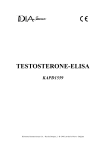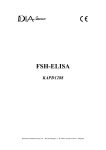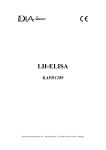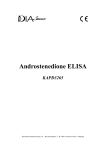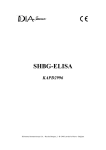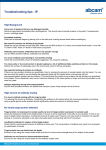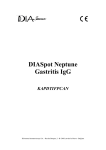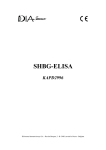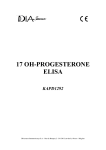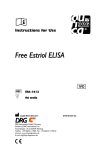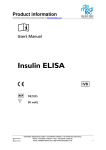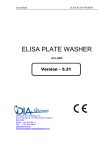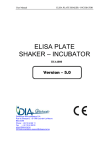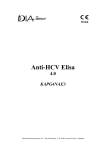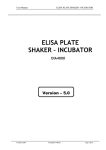Download Free Estriol ELISA - DIAsource Immunoassays
Transcript
Free Estriol ELISA KAPD1612 DIAsource ImmunoAssays S.A. - Rue du Bosquet, 2 - B-1348 Louvain-la-Neuve - Belgium : 140127/1 FREE ESTRIOL ELISA Enzymeimmunoassay for the quantitative measurement of Free Estriol in human serum KAPD1612 IN VITRO DIAGNOSTIC USE en DIAsource ImmunoAssays SA - Rue du Bosquet 2, B-1348 Louvain-la-Neuve, Belgium - Tel: +32 10 84 99 11 - Fax : +32 10 84 99 90 1 1.1 INTRODUCTION Intended Use The DIAsource Free Estriol ELISA is an enzyme immunoassay for the quantitative in vitro diagnostic measurement of free estriol (unconjugated estriol) in serum during the second half of pregnancy. This kit is not intended to be used for the risk evaluation of trisomy 21. 1.2 Summary and Explanation Estriol (E3) is the major estrogen formed by the fetoplacental unit during pregnancy. Unconjugated E3 passes through the placenta into the maternal circulation, where it is rapidly converted into glucuronide and sulfate derivatives to facilitate its excretion. The half-life of estriol in the maternal bloodstream is only 20-30 minutes. Its measurement, therefore offers a convenient and quick evaluation of current fetal status. Plasma estriol levels increase steadily throughout pregnancy and most rapidly during the third trimester (28-40 weeks). A sudden decrease in fetoplacental E3 production will result in a rapid fall in unconjugated E3 in the maternal serum. There are several potential advantages to measuring unconjugated E3 rather than total serum or urinary E3. Unconjugated estriol levels are free from effects related to maternal renal or hepatic disease, and are not altered by the administration of certain antibiotics. Unconjugated E3 more accurately reflects fetal outcome in diabetic pregnancies - and since no hydrolysis of unconjugated E3 is required, a more rapid turnaround for the test result is possible. 2 PRINCIPLE OF THE TEST The DIAsource Free Estriol ELISA Kit is a solid phase enzyme-linked immunosorbent assay (ELISA), based on the principle of competitive binding. The microtiter wells are coated with a polyclonal [rabbit] antibody directed towards an antigenic site on the Estriol molecule. Endogenous Estriol of a patient sample competes with an Estriol-horseradish peroxidase conjugate for binding to the coated antibody. After incubation the unbound conjugate is washed off. The amount of bound peroxidase conjugate is inversely proportional to the concentration of Estriol in the sample. After addition of the substrate solution, the intensity of colour developed is inversely proportional to the concentration of Estriol in the patient sample. 3 PRECAUTIONS This kit is for in vitro diagnostic use only. For professional use only. All reagents of this test kit which contain human serum or plasma have been tested and confirmed negative for HIV I/II, HBsAg and HCV by FDA approved procedures. All reagents, however, should be treated as potential biohazards in use and for disposal. Before starting the assay, read the instructions completely and carefully. Use the valid version of the package insert provided with the kit. Be sure that everything is understood. The microplate contains snap-off strips. Unused wells must be stored at 2 °C to 8 °C in the sealed foil pouch and used in the frame provided. Pipetting of samples and reagents must be done as quickly as possible and in the same sequence for each step. Use reservoirs only for single reagents. This especially applies to the substrate reservoirs. Using a reservoir for dispensing a substrate solution that had previously been used for the conjugate solution may turn solution coloured. Do not pour reagents back into vials as reagent contamination may occur. Mix the contents of the microplate wells thoroughly to ensure good test results. Do not reuse microwells. Do not let wells dry during assay; add reagents immediately after completing the rinsing steps. Allow the reagents to reach room temperature (21-26°C) before starting the test. Temperature will affect the absorbance readings of the assay. However, values for the patient samples will not be affected. Never pipet by mouth and avoid contact of reagents and specimens with skin and mucous membranes. Do not smoke, eat, drink or apply cosmetics in areas where specimens or kit reagents are handled. Wear disposable latex gloves when handling specimens and reagents. Microbial contamination of reagents or specimens may give false results. Handling should be done in accordance with the procedures defined by an appropriate national biohazard safety guideline or regulation. Do not use reagents beyond expiry date as shown on the kit labels. All indicated volumes have to be performed according to the protocol. Optimal test results are only obtained when using calibrated pipettes and microtiter plate readers. Do not mix or use components from kits with different lot numbers. It is advised not to exchange wells of different plates even of the same lot. The kits may have been shipped or stored under different conditions and the binding characteristics of the plates may result slightly different. Avoid contact with Stop Solution containing 0.5 M H2SO4. It may cause skin irritation and burns. Some reagents contain Proclin 300, BND and/or MIT as preservatives. In case of contact with eyes or skin, flush immediately with water. TMB substrate has an irritant effect on skin and mucosa. In case of possible contact, wash eyes with an abundant volume of water and skin with soap and abundant water. Wash contaminated objects before reusing them. If inhaled, take the person to open air. Catalogue Nr: KAPD1612 PI number : 1701129/en Revision Nr : 140127/1 4 Chemicals and prepared or used reagents have to be treated as hazardous waste according to the national biohazard safety guideline or regulation. For information on hazardous substances included in the kit please refer to Material Safety Data Sheets. Material Safety Data Sheets for this product are available upon request directly from DIAsource ImmunoAssays S.A.. KIT COMPONENTS 4.1 Contents of the Kit 1. 2. 3. 4. 5. 6. 7. * CAL 12x8 (break apart) strips, 96 wells; Wells coated with a anti-Estriol antibody (polyclonal). N = 0 to 5, 6 vials, 1 mL, ready to use; See exact values on vial labels N CONTROL Ag HRP CHROM TMB STOP SOLN WASH BND MIT Control Low & High, 2 vials, 1 mL each, ready to use; For control values and ranges please refer to vial label or QC-Datasheet. Contain non-mercury preservative. N SOLN CONC 1 vial, 14 mL, ready to use; Estriol conjugated to horseradish peroxidase; Contain non-mercury preservative 1 vial, 14 mL, ready to use; Tetramethylbenzidine (TMB). 1 vial, 14 mL, ready to use; contains 0.5M H2SO4. Avoid contact with the stop solution. It may cause skin irritations and burns. 1 vial, 30 mL (40X concentrated); see „Preparation of Reagents“. = 5-bromo-5-nitro-1,3-dioxane = 2-methyl-2H-isothiazol-3-one Note: Additional Calibrator 0 for sample dilution is available upon request 4.2 4.3 Materials required but not provided A microtiter plate calibrated reader (450 ± 10 nm). Calibrated variable precision micropipettes. Absorbent paper. Distilled water. Timer Semi logarithmic graph paper or software for data reduction Storage and stability of the Kit When stored at 2-8°C unopened reagents will retain reactivity until expiration date. Do not use reagents beyond this date. Opened reagents must be stored at 2-8°C. Microtiter wells must be stored at 2-8°C. Once the foil bag has been opened, care should be taken to close it tightly again. Opened kits retain activity for two months if stored as described above. 4.4 Preparation of Reagents Allow all reagents and required number of strips to reach room temperature prior to use. Wash Solution Add deionized water to the 40X concentrated W ash Solution. Dilute 30 mL of concentrated Wash Solution with 1170 mL deionized water to a final volume of 1200 mL. The diluted Wash Solution is stable for 2 weeks at room temperature. 4.5 Disposal of the Kit The disposal of the kit must be made according to the national regulations. Special information for this product is given in the Material Safety Data Sheets. 4.6 Damaged Test Kits In case of any severe damage to the test kit or components, DIAsource ImmunoAssays S.A. has to be informed in writing, at the latest, one week after receiving the kit. Severely damaged single components should not be used for a test run. They have to be stored until a final solution has been found. After this, they should be disposed according to the official regulations Catalogue Nr: KAPD1612 PI number : 1701129/en Revision Nr : 140127/1 5 SPECIMEN Serum should be used in this assay. Do not use haemolytic, icteric or lipaemic specimens. Please note: Samples containing sodium azide should not be used in the assay. 5.1 Specimen Collection Serum: Collect blood by venipuncture (e.g. Sarstedt Monovette), allow to clot, and separate serum by centrifugation at room temperature. Do not centrifuge before complete clotting has occurred. Patients receiving anticoagulant therapy may require increased clotting time. 5.2 Specimen Storage Specimens should be capped and may be stored for up to 4 days at 2-8°C prior to assaying. Specimens held for a longer time (least one year) should be frozen only once at -20°C prior to assay. Thawed samples should be inverted several times prior to testing. 5.3 Specimen Dilution If in an initial assay, a specimen is found to contain more than the highest calibrator, the specimens can be diluted with Calibrator 0 and reassayed as described in the Assay Procedure. For the calculation of the concentrations this dilution factor has to be taken into account. Example: a) Dilution 1:10: 10 µL Serum + 90 µL Calibrator 0 (mix thoroughly) b) Dilution 1:100: 10 µL dilution a) 1:10 + 90 µL Calibrator 0 (mix thoroughly). 6 6.1 6.2 TEST PROCEDURE General Remarks All reagents and specimens must be allowed to come to room temperature before use. All reagents must be mixed without foaming. Once the test has been started, all steps should be completed without interruption. Use new disposal plastic pipette tips for each calibrator or sample in order to avoid cross contamination. Absorbance is a function of the incubation time and temperature. Before starting the assay, it is recommended that all reagents are ready, caps removed, all needed wells secured in holder, etc. This will ensure equal elapsed time for each pipetting step without interruption. As a general rule the enzymatic reaction is linearly proportional to time and temperature. Assay Procedure Each run must include a calibration curve. 1. 2. 3. 4. 5. 6. 7. 8. 9. 6.3 1. 2. 3. 4. 5. Secure the desired number of Microtiter wells in the frame holder. Dispense 10 µL of each Calibrator, control and samples with new disposable tips into appropriate wells. Dispense 100 µL Enzyme Conjugate into each well. Thoroughly mix for 10 seconds. It is important to have a complete mixing in this step. Incubate for 60 minutes at room temperature. Briskly shake out the contents of the wells. Rinse the wells 4 times with diluted Wash Solution (400 µL per well). Strike the wells sharply on absorbent paper to remove residual droplets. Important note: The sensitivity and precision of this assay is markedly influenced by the correct performance of the washing procedure! Add 100 µL of Substrate Solution to each well. Incubate for 30 minutes at room temperature. Stop the enzymatic reaction by adding 100 µL of Stop Solution to each well. Determine the absorbance (OD) of each well at 450±10 nm with a microtiter plate reader. It is recommended that the wells be read within 10 minutes after adding the Stop Solution. Calculation of Results Calculate the average absorbance values for each set of calibrators and patient samples. Using semi-logarithmic graph paper, construct a calibration curve by plotting the mean absorbance obtained from each calibrator against its concentration with absorbance value on the vertical(Y) axis and concentration on the horizontal (X) axis. Using the mean absorbance value for each sample determine the corresponding concentration from the calibration curve. Automated method: The results in the IFU have been calculated automatically using a 4 PL (4 Parameter Logistics) curve fit. 4 Parameter Logistics is the preferred method. Other data reduction functions may give slightly different results. The concentration of the samples can be read directly from this calibration curve. Samples with concentrations higher than that of the highest calibrator have to be further diluted. For the calculation of the concentrations this dilution factor has to be taken into account. Example of Typical Calibration Curve The following data is for demonstration only and cannot be used in place of data generations at the time of assay. Catalogue Nr: KAPD1612 PI number : 1701129/en Revision Nr : 140127/1 Optical Units (450 nm) Calibrators OD Calibrator 0 (0.0 ng/mL) 1.79 Calibrator 1 (0.3 ng/mL) 1.48 Calibrator 2 (1.2 ng/mL) 1.18 Calibrator 3 (4.0 ng/mL) 0.81 Calibrator 4 (15.0 ng/mL) 0.52 Calibrator 5 (40.0 ng/mL) 0.38 7 EXPECTED VALUES It is strongly recommended that each laboratory should determine its own normal and abnormal values. 7.1 Normal healthy adults In a study conducted with apparently normal healthy adults, using the DIAsource Free Estriol ELISA the following values are observed: Population 7.2 Valid N 5% Percentile [ng/mL] 95% Percentile [ng/mL] Males 42 0.146 0.573 Females (not pregnant) 43 0.057 0.822 Values during pregnancy Week of gestation p.m. Expected range Expected range Twin pregnancy (ng/mL) Week of gestation p.m. 12 (ng/mL) (ng/mL) 0,3 - 1,0 22 - 23 2,7 - 16 3 - 18 13 0,3 - 1,1 24 - 25 2,9 - 17 3 - 20 14 0,4 - 1,6 26 - 27 3,0 - 18 4 - 21 15 1,0 - 4,4 28 - 29 3,2 - 20 4 - 22 16 1,4 - 6,5 30 - 31 3,6 - 22 5 - 25 17 1,5 - 6,6 32 - 33 4,6 - 23 6 - 39 18 1,6 - 8,5 34 - 35 5,1 - 25 7 - 39 19 1,9 - 11 36 - 37 7,2 - 29 9 - 38 20 2,1 - 13 38 - 39 7,8 - 37 13 - 40 21 2,6 - 14 40 - 42 8,0 - 39 --- CLINICAL SIGNIFICANCE The measurement of Estriol (E3) in body fluids has routinely been used for the monitoring and management of fetal well-being, particularly in the high-risk pregnant patient. The concentration of E3 in plasma increases gradually during the first 20 weeks gestation and more rapidly during the third trimester. Since the ranges for normal and abnormal serum conjugated E3 are wide and overlap considerably, a single E3 determination is of little value. The patient should be monitored frequently to establish any individual trend. Consistently low levels or a sudden and continual decrease of serum E3 during the third trimester is highly indicative of fetal distress and possibly intrauterine death. When such observations are made, the status of the fetus should be assessed by alternative methods. Interpretation of serum unconjugated E3 levels should be made in conjunction with other clinical tests or diagnostic procedures such as amniocentesis and ultrasound. Subnormal E3 levels may also be observed in patients being administered certain antibiotics or corticosteroids or in patients with impaired maternal hepatic function. 8 QUALITY CONTROL Good laboratory practice requires that controls be run with each calibration curve. A statistically significant number of controls should be assayed to establish mean values and acceptable ranges to assure proper performance. It is recommended to use control samples according to state and federal regulations. The use of control samples is advised to assure the day to day validity of results. Use controls at both normal and pathological levels. The controls and the corresponding results of the QC-Laboratory are stated in the QC certificate added to the kit. The values and ranges stated on the QC sheet always refer to the current kit lot and should be used for direct comparison of the results. It is also recommended to make use of national or international Quality Assessment programs in order to ensure the accuracy of the results. Employ appropriate statistical methods for analysing control values and trends. If the results of the assay do not fit to the established acceptable ranges of control materials patient results should be considered invalid. In this case, please check the following technical areas: Pipetting and timing devices; photometer, expiration dates of reagents, storage and incubation conditions, aspiration and washing methods. After checking the above mentioned items without finding any error contact your distributor or DIAsource ImmunoAssays S.A. directly. Catalogue Nr: KAPD1612 PI number : 1701129/en Revision Nr : 140127/1 9 ASSAY CHARACTERISTICS 9.1 Assay Dynamic Range The range of the assay is between 0.075 – 40 ng/mL. 9.2 Specificity of Antibodies (Cross Reactivity) The following substances were tested for cross reactivity of the assay: concentration of steroid OD (450 nm) Measured concentration Estriol (E3) added steroid 40 ng/ml 0,39 39,67 ng/ml Testosterone 16 ng/ml 1,758 n.d. Estradiol (E2) 2 ng/ml 1,579 n.d. 2 ng/ml 1,712 n.d. 800 ng/ml 1,775 n.d. Estrone (E1) Cortisol n.d. = non detectable 9.3 Analytical Sensitivity The analytical sensitivity was calculated from the mean minus two standard deviations of twenty (20) replicate analyses of Calibrator 0 and was found to be 0.075 ng/mL. 9.4 Precision 9.4.1 Intra Assay Variation The within assay variability is shown below: Sample n Mean (ng/mL) 9.4.2 CV (%) 1 20 2.1 4.7 2 20 6.2 3.2 3 20 14.6 3.0 Inter Assay Variation The inter assay variability (three different kit lots) is shown below: The between-assay variability is shown below: 9.5 Sample n Mean (ng/mL) CV (%) 1 12 2.1 4.6 2 12 5.7 8.5 3 12 13.3 9.5 Recovery Recovery of the DIAsource ELISA was determined by adding increasing amounts of the analyte to three different patient sera containing different amounts of endogenous analyte. Each sample (non-spiked and spiked) was assayed and analyte concentrations of the samples were calculated from the calibration curve. The percentage recoveries were determined by comparing expected and measured values of the samples. Sample 1 Sample 2 Sample 3 Concentration [ng/mL] 1.32 3.59 7.79 Average Recovery 100.8 101.8 106.9 from 89.0 92.3 98.5 to 103.8 109.8 112.3 Sample 1 Sample 2 Sample 3 Concentration [ng/mL] 2.63 7.18 15.58 Average Recovery 98.2 99.7 100.2 from 86.3 90.4 96.4 to 107.9 106.8 103.7 Range of Recovery [%] 9.6 Linearity Range of Recovery [%] Catalogue Nr: KAPD1612 PI number : 1701129/en Revision Nr : 140127/1 10 LIMITATIONS OF USE Reliable and reproducible results will be obtained when the assay procedure is performed with a complete understanding of the package insert instruction and with adherence to good laboratory practice. Any improper handling of samples or modification of this test might influence the results. 10.1 Interfering Substances Haemoglobin (up to 4 mg/mL), Bilirubin (up to 0.125 mg/mL) and Triglyceride (up to 30 mg/mL) have no influence on the assay results. 10.2 Drug Interferences Until today no substances (drugs) are known to us, which have an influence to the measurement of Free Estriol in a sample. 10.3 High-Dose-Hook Effect No hook effect was observed in this test. 11 11.1 LEGAL ASPECTS Reliability of Results The test must be performed exactly as per the manufacturer’s instructions for use. Moreover the user must strictly adhere to the rules of GLP (Good Laboratory Practice) or other applicable national standards and/or laws. This is especially relevant for the use of control reagents. It is important to always include, within the test procedure, a sufficient number of controls for validating the accuracy and precision of the test. The test results are valid only if all controls are within the specified ranges and if all other test parameters are also within the given assay specifications. In case of any doubt or concern please contact DIAsource. 11.2 Therapeutic Consequences Therapeutic consequences should never be based on laboratory results alone even if all test results are in agreement with the items as stated under point 11.1. Any laboratory result is only a part of the total clinical picture of a patient. Only in cases where the laboratory results are in acceptable agreement with the overall clinical picture of the patient should therapeutic consequences be derived. The test result itself should never be the sole determinant for deriving any therapeutic consequences. 11.3 Liability Any modification of the test kit and/or exchange or mixture of any components of different lots from one test kit to another could negatively affect the intended results and validity of the overall test. Such modification and/or exchanges invalidate any claim for replacement. Claims submitted due to customer misinterpretation of laboratory results subject to point 11.2. are also invalid. Regardless, in the event of any claim, the manufacturer’s liability is not to exceed the value of the test kit. Any damage caused to the test kit during transportation is not subject to the liability of the manufacturer. 12 REFERENCES Bashore, R.A., Westlake, J.R. Plasma unconjugated estriol values in high risk pregnancy. Am. J. Obstet. Gynecol., June 15, 1977, p371-380 Revision date : 2014-01-27 Catalogue Nr: KAPD1612 PI number : 1701129/en Revision Nr : 140127/1 FREE ESTRIOL ELISA Enzymeimmunoassay for the quantitative measurement of Free Estriol in human serum KAPD1612 IN VITRO DIAGNOSTIC USE es DIAsource ImmunoAssays SA - Rue du Bosquet 2, B-1348 Louvain-la-Neuve, Belgium - Tel: +32 10 84 99 11 - Fax : +32 10 84 99 90 1 INTRODUCCIÓN El Kit de inmunoensayo enzimático DIAsource Free Estriol ELISA proporciona los materiales necesarios para la determinación cuantitativa del Estriol libre en suero. Este ensayo está diseñado solo para diagnóstico in vitro. Este kit no esta destinado por ser utilizado para la evaluación de riesgo de trisomia 21. 2 FUNDAMENTO DEL ENSAYO El Kit DIAsource Free Estriol ELISA es un ensayo en fase sólida de inmunoadsorción unido a enzimas (ELISA), basado en el principio de unión competitiva. Los pocillos de las placas están recubiertos con un anticuerpo policlonal dirigido contra un foci antigénico en la molécula Estriol. En las muestras de los pacientes Estriol compite con un conjugado Estriol -peroxidasa de rábano en la unión al anticuerpo inmovilizado. Después de la incubación el conjugado no unido se lava. La cantidad de conjugado de peroxidasa unido es inversamente proporcional a la concentración de Estriol en la muestra. Después de la adición de la solución sustrato, la intensidad de color desarrollado es inversamente proporcional a la concentración de Estriol libre en la muestra del paciente. 3 PRECAUCIONES Este kit es solamente para diagnóstico in vitro. Por favor, se usa solo la version valida de la metodico técnico incluido aqui en el kit. Para obtener información de las sustancias peligrosas incluidas en el kit por favor mirar las hojas de los datos de seguridad del material. Todos los reactivos en este kit de ensayo que contienen suero o plasma humano se han ensayado y confirmado ser negativos para HIV I/II, HBsAg y HCV mediante procedimientos aprobados por la FDA. Sin embargo, todos los reactivos deben ser tratados tanto en su uso como dispensación como potencialmente biopeligrosos. Evitar contacto con Stop Solution que contiene H2SO4 0,5 M. Puede provocar irritación y quemaduras en la piel. Nunca pipetear con la boca y evitar el contacto de los reactivos y las muestras con la piel y con membranas mucosas. No fumar, comer, beber o usar cosméticos en áreas donde las muestras o los reactivos del kit están siendo usados. Usar guantes de látex cuando se utilicen las muestras y los reactivos. La contaminación microbiana de los reactivos o las muestras puede dar resultados erróneos. El manejo debe realizarse de acuerdo a los procedimientos definidos por las guías o regulación nacionales de seguridad de sustancias biopeligrosas. No utilizar los reactivos después de su fecha de caducidad que aparece en las etiquetas del kit. Todos los volúmenes indicados han de ser realizados de acuerdo con el protocolo. Los resultados óptimos del ensayo se obtienen solo cuando se utilizan pipetas y lectores de microplacas calibrados. No mezclar o usar componentes de kits con distinto número de lote. Se recomienda no intercambiar pocillos de distintas placas incluso si son del mismo lote. Los kits pueden haber sido enviados o almacenados bajo diferentes condiciones y las características de unión de las placas pueden resultar diferentes. Los compuestos químicos y los reactivos preparados o utilizados han de tratarse como residuos peligrosos de acuerdo con las guías o regulación nacionales de seguridad de sustancias biopeligrosas. Las hojas de los datos de seguridad de este producto están disponibles bajo pedido directamente a DIAsource ImmunoAssays S.A. Las hojas de los datos de seguridad se ajustan a las demandas de las guía europea: EU-Guideline 91/155 EC. Catalogue Nr: KAPD1612 PI number : 1701129/es Revision Nr : 140127/1 4 4.1 COMPONENTES DEL KIT Componentes del Kit 1. 2. 3. 4. 5. Microtiterwells (Placas multipocillo), 12 x 8 tiras separables, 96 pocillos; Pocillos recubiertos con anticuerpo anti- Estriol (policlonal). CAL Calibrador (Calibrador 0-5), 6 viales, 1 mL, listo para usar; Concentraciones: 0 - 0.3 - 1.2 - 4 - 15 - 40 ng/mL N CONTROL Control Low & High, 2 viales, 1 mL, listo para usar; Referir los valores y rangos del control a la etiqueta del vial o a la Hoja de datos QC. Contiene conservante. N Enzyme Conjugate (Conjugado enzimático), 1 vial, 14 mL, listo para usar, Estriol conjugado con la Peroxidasa de rábano;; Contiene conservante sin mercurio. Ag HRP CHROM TMB Substrate Solution (Solución de sustrato), 1 vial, 14 mL, listo para usar, Tetrametilbencidina (TMB). STOP SOLN Stop Solution (Solución de parada), 1 vial, 14 mL, listo para usar, contiene 0.5 M H2SO4, Evitar el contacto con la Solución de parada. Puede causar irritación y quemaduras en al piel. WASH SOLN 6. 7. CONC Wash Solution (Solución de lavado), 1 vial, 30 mL (concentrado 40X), ver “Preparación de los Reactivos”. * BND MIT = 5-bromo-5-nitro-1,3-dioxane = 2-methyl-2H-isothiazol-3-one Nota: Se puede solicitar el Calibrador 0 para la dilución de la muestra. 4.2 4.3 Equipamiento y material requerido pero no provisto Lector de microplacas calibrado (450 ± 10 nm) (ej. Microtiter Plate Reader). Micropipetas de precisión variable calibradas. Papel absorbente. Agua destilada. Almacenamiento y estabilidad del kit Cuando se almacena a 2 °C - 8 °C, los reactivos sin abrir mantienen su reactividad hasta la fecha de caducidad. No utilizar los reactivos más allá de esta fecha. Los reactivos abiertos han de almacenarse a 2 °C - 8 °C. Las placas multipocillo han de almacenarse a 2 °C - 8 °C. Una vez se ha abierto la bolsa hay que tener cuidado y cerrarla de nuevo. Los kits abiertos conservan su actividad durante dos meses si se almacenan como se ha descrito arriba. 4.4 Preparación de los Reactivos Dejar que todos los reactivos y el número requerido de tiras alcancen la temperatura ambiente antes de usarse. Wash Solution Mezclar 30 mL de Wash Solution concentrada con 1170 mL de agua desionizada hasta un volumen final de 1200 mL. La solución del lavado diluida es estable durante 2 semanas a temperatura ambiente. 4.5 Eliminación del Kit La eliminación del kit debe realizarse de acuerdo con las leyes nacionales. En las hojas de datos de seguridad se proporciona información especial de este producto. 4.6 Kits de ensayo dañados En caso de que exista cualquier daño severo del kit de ensayo o de sus componentes, ha de informarse por escrito a DIAsource ImmunoAssays S.A. no mas tarde de una semana después de recibir el kit. No deben utilizarse componentes dañados para llevar a cabo un ensayo. Han de almacenarse hasta que se encuentre una solución. Después de esto, deben ser eliminados de acuerdo con las leyes oficiales. Catalogue Nr: KAPD1612 PI number : 1701129/es Revision Nr : 140127/1 5 MUESTRAS En este ensayo pueden usarse suero. No usar muestras hemolíticas, ictéricas o lipémicas. Tener en cuenta: No deben usarse muestras que contengan acida sódica. 5.1 Toma de muestras Suero: Recoger la sangre por punción en la vena (ej. Sarstedt Monovette para el suero), permitir coagulación, y separar el suero por centrifugación a temperatura ambiente. No centrifugar antes de la coagulación completa. Las muestras de pacientes que reciben terapia anticoagulante requieren más tiempo para coagular. 5.2 Almacenamiento de las muestras Las muestras deben ser tapadas y pueden ser almacenadas hasta 4 días a 2 °C a 8 °C antes del ensayo. Las muestras almacenadas por un período de tiempo mas largo (al menos un año) han de congelarse sólo una vez a -20°C antes del ensayo. Las muestras descongeladas deben invertirse varias veces antes del ensayo. 5.3 Dilución de las muestras Si en un ensayo inicial, se encuentra una muestra que presenta valores mayores que el calibrador mas concentrado, ha de diluirse con Calibrador 0 y volver a ensayarse como se describe en el Procedimiento de Ensayo. Para el cálculo de las concentraciones habrá que tener en cuenta el factor de dilución. Ejemplo: a) dilución 1:10: b) dilución 1:100: 6 6.1 6.2 10 µL Suero + 90 µL Calibrador 0 (mezclar totalmente) 10 µL dilución a) 1:10 + 90 µL Calibrador 0 (mezclar totalmente). PROCEDIMIENTO DE ENSAYO Consideraciones generales Todos los reactivos y muestras han de estar a temperatura ambiente antes de su uso. Todos los reactivos deben mezclarse sin formar espuma. Una vez se ha comenzado el ensayo deben completarse todos los pasos sin interrupción. Utilizar puntas de pipeta de plástico nuevas para cada estándar, control o muestra para evitar combinaciones cruzadas. La absorbancia es función del tiempo de incubación y la temperatura. Antes de comenzar el ensayo, se recomienda que todos los reactivos estén preparados, tapas removidas, todos los pocillos que se necesiten asegurados en recipiente, etc. Esto asegurará un tiempo similar para cada paso de pipeteo sin que haya interrupciones. Como regla general, la reacción enzimática es linealmente proporcional al tiempo y a la temperatura. Procedimiento de ensayo Cada uno debe incluir una curva de calibradors. 1. Asegurar el número deseado de pocillos en el recipiente. 2. Dispensar 10 µL de cada Calibrador, Control y muestras con puntas nuevas en los pocillos adecuados. 3. Dispensar 100 µL de Enzyme Conjugate a cada pocillo. Mezclar totalmente durante 10 segundos. Es importante mezclar completamente en este paso. 4. Incubar durante 60 minutes a temperatura ambiente. 5. Sacudir enérgicamente el contenido de los pocillos. Lavar los pocillos 4 veces con Wash Solution diluida (400 µL por pocillo). Realizar un golpe seco de los pocillos contra el papel absorbente para eliminar las gotas residuales. Nota importante: La sensibilidad y la precisión de este ensayo se ve marcadamente influenciada por la realización correcta del proceso de lavado! 6. Adicionar 100 µL de Substrate Solution a cada pocillo. 7. Incubar durante 30 minutes a temperatura ambiente. 8. Parar la reacción enzimática mediante la adición de 100 µL de Stop Solution a cada pocillo. 9. Leer la OD a 450 ± 10 nm con un lector de microplacas dentro de los 10 minutos después de la adición de la Stop Solution.. 6.3 1. 2. 3. 4. 5. Cálculo de los Resultados Calcular los valores de absorbancia media para cada conjunto de calibradors, controles y muestras de pacientes. Construir una curva calibrador mediante la representación de la absorbancia media obtenida para cada calibrador frente a su concentración con el valor de absorbancia en el eje vertical (Y) y la concentración en el eje horizontal (X). Usando el valor de absorbancia media de cada muestra determinar la concentración correspondiente a partir de la curva estándar. Método automatizado: Los resultados en las instrucciones de uso se han calculado automáticamente usando una curva de regresión 4 Parámetros. (4 Parámetros Rodbard o 4 Parámetros Marquardt son los métodos preferidos.) Otras funciones de regresión darán lugar a resultados sensiblemente diferentes. La concentración de las muestra puede leerse directamente de la curva de calibradors. Las muestras con concentraciones superiores al mayor calibrador han de diluirse. Para el cálculo de las concentraciones hay que tener en cuenta el factor de dilución. Catalogue Nr: KAPD1612 PI number : 1701129/es Revision Nr : 140127/1 6.3.1 Ejemplo de una Curva Calibrador Típica Los siguientes datos son solamente para la explicación y no pueden ser utilizados en lugar de los datos generados en el momento del ensayo. Calibrador Unidades Ópticas (450 nm) Calibrador 0 (0.0 ng/mL) 1,79 Calibrador 1 (0.3 ng/mL) 1,48 Calibrador 2 (1.2 ng/mL) 1,18 Calibrador 3 (4.0 ng/mL) 0,81 Calibrador 4 (15.0 ng/mL) 0,52 Calibrador 5 (40.0 ng/mL) 0,38 7 VALORES ESPERADOS Se recomienda encarecidamente que cada laboratorio determine sus valores normales e inusuales. 7.1 Valores con adultos aparentemente sanos En un estudio con adultos aparentemente sanos utilizando el DIAsource Free Estriol ELISA se observaron los siguientes valores: 7.2 Población N válido Percentil 5% [ng/mL] Percentil 95% [ng/mL] Hombres 42 0.146 0.573 Mujeres 43 0.057 0.822 Valores durante embarazo (p.m. = post menstruationem) Semanas de embarazo p.m. 12 13 14 15 16 17 18 19 20 21 (ng/mL) 0,3 - 1,0 0,3 - 1,1 0,4 - 1,6 1,0 - 4,4 1,4 - 6,5 1,5 - 6,6 1,6 - 8,5 1,9 - 11 2,1 - 13 2,6 - 14 Semanas de embarazo p.m. 22 - 23 24 - 25 26 - 27 28 - 29 30 - 31 32 - 33 34 - 35 36 - 37 38 - 39 40 - 42 embarazo con gemelo (ng/mL) 2,7 - 16 2,9 - 17 3,0 - 18 3,2 - 20 3,6 - 22 4,6 - 23 5,1 - 25 7,2 - 29 7,8 - 37 8,0 - 39 (ng/mL) 3 - 18 3 - 20 4 - 21 4 - 22 5 - 25 6 - 39 7 - 39 9 - 38 13 - 40 --- TENER EN CUENTA: Para importancia clínica consultar el manual de usuario en inglés (Capítulo 7: EXPECTED VALUES) 8 CONTROL DE CALIDAD Se recomienda usar muestras control de acuerdo con las leyes estatales y federales. El uso de muestras control ser recomienda para asegurar la validez diaria de los resultados. Usar controles tanto a niveles normal como patológico. Los controles y los correspondientes resultados del Laboratorio de control de calidad están fijados en el certificado de control de calidad que acompañan al kit. Los valores y los rangos fijados en la hoja del control de calidad se refieren siempre al kit actual y deben usarse para la comparación directa de los resultados. Es recomendable también hacer uso de programas de Aseguramiento de la Calidad nacionales o internacionales para asegurar la exactitud de los resultados. Utilizar métodos estadísticos apropiados para el análisis de los valores y tendencia de los controles. Si los resultados del ensayo no se ajustan a los rangos aceptables establecidos en los controles, los resultados obtenidos de los pacientes han de considerarse inválidos. En este caso, por favor comprobar las siguientes áreas técnicas: Pipeteo y tiempo empleado, fotómetro, fecha de caducidad de los reactivos, condiciones de almacenamiento e incubación, métodos de aspiración y lavado. Catalogue Nr: KAPD1612 PI number : 1701129/es Revision Nr : 140127/1 Después de comprobar los asuntos mencionados arriba sin encontrar ningún error, contactar con su distribuidor o con DIAsource ImmunoAssays S.A. directamente. 9 9.1 CARACTERÍSTICAS DEL ENSAYO Rango dinámico del ensayo El rango del ensayo se encuentra entre 0,075 – 40 ng/mL. 9.2 Especificidad de los Anticuerpos (Reactividad Cruzada) Consultar el manual de usuario en inglés. 9.3 Sensibilidad Analítica La sensibilidad analítica se calculó a partir de la media menos dos desviaciones calibrador de veinte (20) réplicas del Calibrador 0 y resultó ser 0,075 ng/mL. 9.4 Precisión Consultar el manual de usuario en inglés. 9.5 Recuperación Consultar el manual de usuario en inglés. 9.6 Linealidad Consultar el manual de usuario en inglés. 10 LIMITACIONES DE USO Cualquier manipulación inadecuada de las muestras o modificaciones del ensayo pueden influenciar los resultados. 10.1 Sustancias que pueden interferir Hemoglobina (hasta 4 mg/mL), Bilirrubina (hasta 0.125 mg/mL) y Triglicéridos (hasta 30 mg/mL) no influencian los resultados del ensayo. 10.2 Interferencias con drogas Hasta ahora no se han encontrado sustancias (drogas) conocidas por nosotros, que tengan influencia en la medida de Estriol libre en una muestra. 10.3 Efecto Gancho-Dosis-Elevada No se ha observado efecto gancho en este ensayo. 11 11.1 ASPECTOS LEGALES Fiabilidad de los Resultados El ensayo debe realizarse exactamente de acuerdo a las instrucciones del fabricante. Mas aún, el usuario debe ajustarse estrictamente a las reglas BPL (Buenas Prácticas de Laboratorio) o a otros calibradors y/o leyes nacionales aplicables. Esto es especialmente relevante para el uso de reactivos control. Es importante incluir siempre, dentro del procedimiento de ensayo, un número suficiente de controles para validar la exactitud y la precisión del ensayo. Los resultados del ensayo son válidos sólo si todos los controles se encuentran dentro de los rangos especificados y si todos los otros parámetros del ensayo se encuentran dentro de las especificaciones dadas para el ensayo. En cado de alguna duda o inquietud, por favor, contactar con DIAsource ImmunoAssays S.A. 11.2 Consecuencias Terapéuticas Las consecuencias terapéuticas nunca deben basarse sólo en los resultados de laboratorio incluso si todos los resultados del ensayo están de acuerdo con los asuntos fijados en el punto 11.1. Cualquier resultado de laboratorio es solamente una parte del cuadro clínico de un paciente. Solamente en los casos donde los resultados de laboratorio están en acuerdo con todo el cuadro clínico de un paciente, se pueden derivar consecuencias terapéuticas. Nunca deben derivarse consecuencias terapéuticas a partir de solamente el resultado obtenido en el ensayo Catalogue Nr: KAPD1612 PI number : 1701129/es Revision Nr : 140127/1 11.3 Responsabilidad Cualquier modificación del kit y/o cambio o mezcla de cualquier componente procedentes de kits de lotes diferentes puede afectar negativamente a los resultados esperados y en la validez de todo el test. Esas modificaciones y/o cambios invalidad cualquier reclamación de reposición. Las reclamaciones emitidas debidas a una mala interpretación de los resultados de laboratorio por parte del comprador referidos al punto 11.2 son también inválidas. A pesar de todo, en el caso de cualquier reclamación, la responsabilidad del fabricante no excede el valor del kit. Cualquier daño provocado al kit durante su transporte no está sujeto a la responsabilidad del fabricante. 12 REFERENCIAS / BIBLIOGRAFÍA Consultar el manual de usuario en inglés. Fecha de revisión: 2014-01-27 Catalogue Nr: KAPD1612 PI number : 1701129/es Revision Nr : 140127/1 P.I. Number : 1701000 Used symbols Consult instructions for use Storage temperature Use by Batch code Catalogue number Control In vitro diagnostic medical device Manufacturer Contains sufficient for <n> tests WASH SOLN CAL 0 CAL N CONTROL CONC Wash solution concentrated Zero calibrator Calibrator # N Control # Tracer Ag 125I Ab 125I Ag 125I CONC Tracer concentrated Ab 125I CONC Tracer concentrated INC BUF Tracer Tubes Incubation buffer Acetonitrile ACETONITRILE Serum SERUM DIL SPE Specimen diluent DIL BUF Dilution buffer ANTISERUM Antiserum IMMUNOADSORBENT Immunoadsorbent DIL CAL Calibrator diluent REC SOLN Reconstitution solution Polyethylene glycol PEG EXTR SOLN Extraction solution ELU SOLN Elution solution Bond Elut Silica cartridges GEL PRE Pre-treatment solution SOLN NEUTR Neutralization solution SOLN TRACEUR Tracer buffer BUF Microtiterplate HRP Conjugate Ab HRP Ag HRP Ab HRP CONC HRP Conjugate concentrate Ag HRP CONC HRP Conjugate concentrate CONJ BUF CHROM TMB CHROM TMB HRP Conjugate Conjugate buffer CONC Chromogenic TMB concentrate Chromogenic TMB solution Substrate buffer SUB BUF STOP SOLN Stop solution INC SER Incubation serum Buffer BUF Ab AP SUB PNPP AP Conjugate Substrate PNPP BIOT CONJ CONC Biotin conjugate concentrate AVID HRP CONC Avidine HRP concentrate ASS BUF Assay buffer Ab BIOT Biotin conjugate Specific Antibody Ab SAV HRP CONC 2nd Antibody 2nd Ab ACID Streptavidin HRP concentrate Non-specific binding NSB Acidification Buffer BUF Distributor DIST Incubation trays TRAY PMSF solution PMSF Protect from light Dot Strip STRIP Substrate SUB EXTR SOLN HRP Streptavidin HRP Pipette PIPETTE WASH Extraction Buffer Concentrate Cartridge CART SAV CONC SOLN Wash buffer Revision nr 130513 P.I. Number : 1701000 Revision nr 130513 Símbolos utilisados Consultar las instrucciones de uso Limitación de temperatura Fecha de caducidad Codigo de lote Número de catálogo Control Producto sanitario para diagnóstico in vitro Fabricante Contenido suficiente para <n> ensayos WASH CAL SOLN 0 CONC CAL Calibrador # N CONTROL Solución de lavado concentrada Calibrador cero 0 N Control # Trazador Ag 125I Ab 125I Ag 125I CONC Trazador concentrada Ab 125I CONC Trazador concentrada INC BUF Trazador Tubos Tampón de incubación Acetonitrilo ACETONITRILE Suero SERUM DIL SPE Diluyente de Muestra DIL BUF Tampón de dilución ANTISERUM Antisuero IMMUNOADSORBENT Inmunoadsorbente DIL CAL Diluyente de calibrador REC SOLN Solución de Reconstitución Glicol Polietileno PEG EXTR SOLN Solución de extracción ELU SOLN Solución de elución Cartuchos Bond Elut Silica GEL PRE Solución de Pre-tratamiento SOLN NEUTR Solución de Neutralización SOLN TRACEUR Tampón de trazador BUF Placa de microvaloración HRP Conjugado Ab HRP Ag HRP Ab HRP CONC HRP Conjugado concentrada Ag HRP CONC HRP Conjugado concentrada CONJ BUF CHROM TMB CHROM TMB HRP Conjugado Tampón de Conjugado CONC Cromógena TMB concentrada Solución Cromógena TMB SUB BUF Tampón de sustrato STOP SOLN Solución de Parada INC SER Suero de Incubación Tampón BUF Ab AP SUB PNPP AP Conjugado Sustrato PNPP BIOT CONJ CONC Concentrado de conjugado de biotina AVID HRP CONC Concentrado avidina-HRP ASS BUF Tampón de ensayo Ab BIOT Conjugado de biotina Anticuerpo específico Ab SAV HRP CONC Estreptavidina-HRP Concentrado Unión no específica NSB 2nd Ab Segundo anticuerpo ACID Tampón de Acidificación BUF Distribuidor DIST Bandejas de incubación TRAY Solución de PMSF PMSF Proteger de la luz Tries Dot STRIP Sustrato SUB EXTR SOLN Concentrado de tampón de extracción Cartucho CART SAV HRP PIPETTE WASH CONC SOLN Estreptavidina HRP Pipeta Tampón de lavado
















